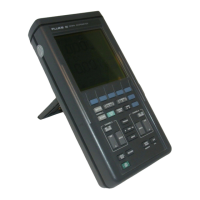3-24
CIRCUIT DESCRIPTIONS
ADC
The
output
signal SNGOUT (pin
18)
of
the
A-ASIC Is
fed to the
e-bit Analog
Digital
Converter TDA 8703. This component operates on a 2S MHz clocK signal. The
signal TRACKN Is
delayed to compensate
for the internal
signal delay in ^e A-ASIC (behind the
Track & Hold section) and is fed to ADC pin 17.
The ADC provides for the reference voltage needed by the A-ASIC. This reference voltage is derived
from
the ADC.
V/REF
is made of the
voltages
on pin
4
(VRB
«
Reference Bottom Voltage: .5V) and
pen
9
(VRT
= Reference
Top Vottage: +3.5V) of the ADC. During normal operating conditions this
reference voltage, VREF, is +2.5V {+/-
3-6%,
ref.
to
ground). VREF is
adjusted
with
potent!
omeler
R2346, marked "OFFSET" andean be measured between TP331
and
ground. The ser>sitivity of
the
ADC is adjusted with B2347, marked "GAIN". These calibrations are described In chapter
5,
section
5.6.1: “Hardware SCOPE Calibration Adjustments
The
8-bit output
of
the ADC: ADCO.mADC? Is connected to the Digital ASIC on the digital Af PCB.
3.4.6 ANALOG CONTROL CIRCUIT
•
Introduction
See
figure
3.13.
The various sectlor^s
of the ScepeMeter, situated on the analog A2 PCB, are controlled by the
microprocessor on the digital A1 PCB. This is done by means of the CCLK (serial clock), CDAT (serial
data) and DTAE (data-iatch) lines. This bus system creates several control signals, which for example
drive the relays switches in the attenuator sections.
-
Detailed circuit description
See figure 3.13 and circuit diagram A2a (figure 10.5).
MAJNVOLThfT
OFFSeT-CO«P€NS*TION
LF<CALI9RATK)N
WAVEFOflM SeiKTION
Figure 3. IS Schematic diagram analog control circuitry
RELAYS
swrrCHES
(ATT SECnONi
Each shift register transforms the
serial
signal COAT Into
8
parallel control signals. This Is done by
means of the serial dock signal CCLK and the data-latch signals DTAEa, DTAEb and DTAEc. The
control circuitry
comprises
two
series
of
cascaded shift
registers:
D2907-D2908-D2909 (24 signals)
and D2904- 02906(16 aignals).
The signals, that are made by the shift registers, are used:
-
to control the buffers (D2901 / D2902 / D2903), which drive the relays In the attenuator section.
-
for offset compensation (A-RANGE and B-RANGE) in the attenuator sections.
•
for
L.F. -calibration (A-OFFSET
and
B-OFFSET)
In the
attenuator
sections.
-
to select the waveform in the signal generator
section
(sine
wave/squarewave/DC).
•
to drive the buzzer
(beeper).

